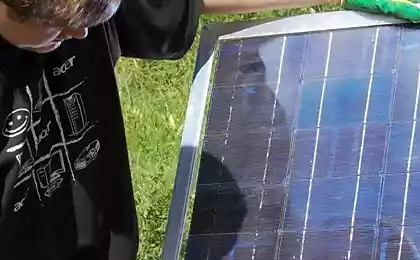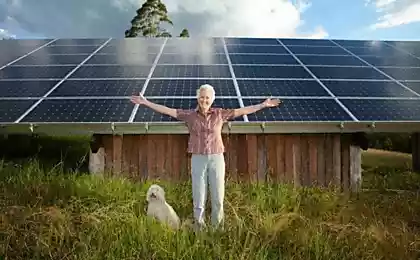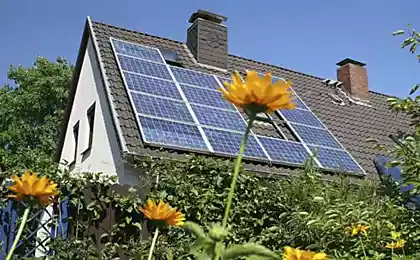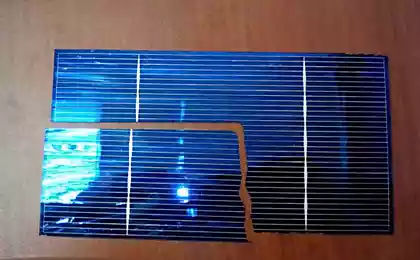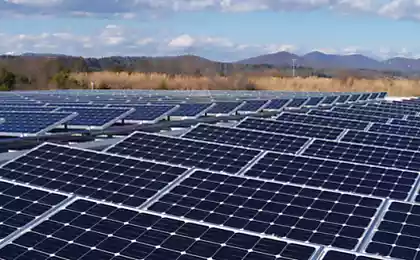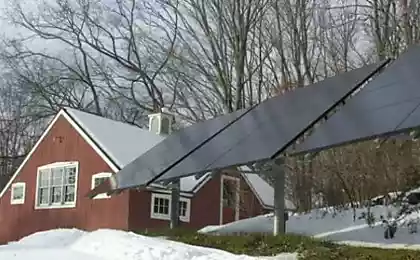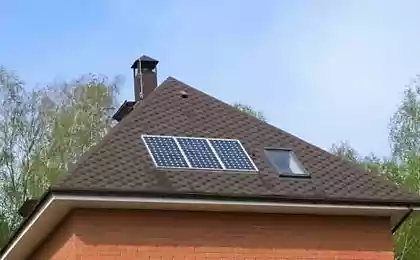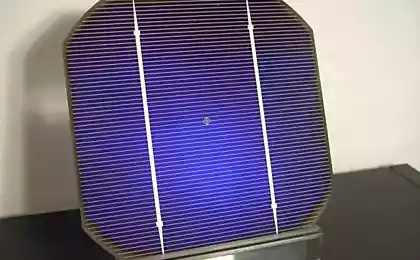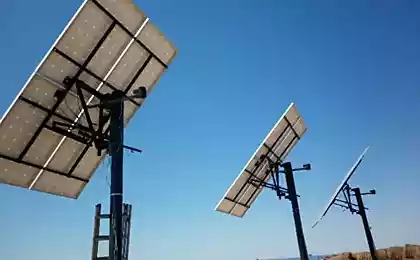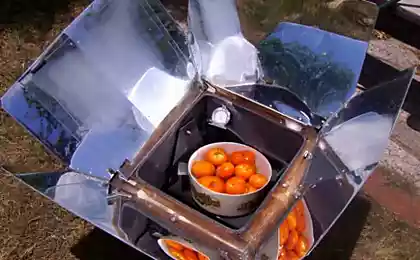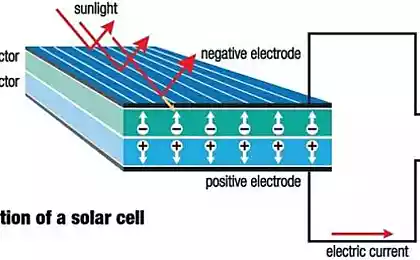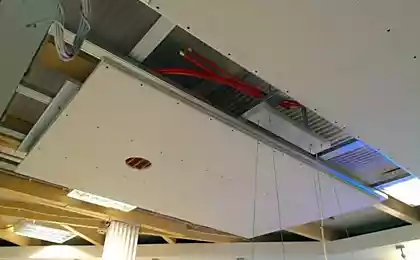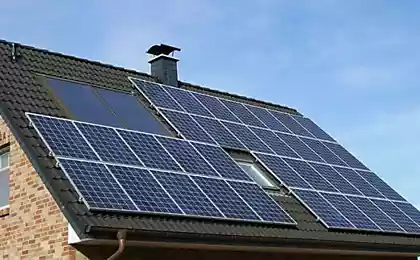654
The list of the most efficient solar panels
Lately, solar energy is developing so rapidly that in 10 years the share of solar electricity in the world annual electricity generation increased from 0.02% in 2006 to almost one percent in 2016.

Dam Solar Park, the largest SES in the world. The capacity of 850 megawatts.
The basic material for solar power plants is silicon, the supplies of which on Earth is almost inexhaustible. One problem – the efficiency of silicon solar cells is poor. The most efficient solar panels have an efficiency not exceeding 23%. And the average efficiency ranges from 16% to 18%. Therefore, researchers around the world engaged in the field of solar photovoltaics, working in order to make solar photovoltaics the image of the dear supplier of electricity.
Developed this struggle for the creation of the solar SuperCell. The main criteria – high efficiency and low cost. National laboratory of renewable energy sources (NREL) in the United States even publishes periodically a Bulletin describing interim results of this struggle. And each issue shows the winners and losers, outsiders and upstarts accidentally get involved in this race.
Leader: multilayer solar cell, These helium converters resemble a sandwich of different materials, including perovskite, silicon, and thin films. With each layer absorbs only light of a specific wavelength. As a result, these with an equal area of the working surface of the multilayer helium cells produce much more energy than others.
The record value of efficiency multilayer solar cells has been achieved at the end of 2014 a joint German-French group of researchers under the direction of Dr. Frank Dimroth at the Fraunhofer Institute for solar energy systems. Was efficiency achieved in 46%. Such a fantastic efficiency value was confirmed by an independent study at NMIJ/AIST is the largest metrological center of Japan.
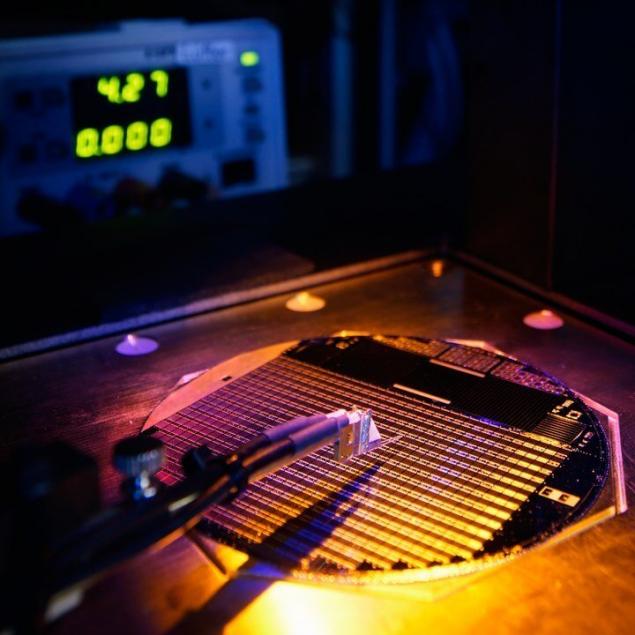
The multilayer solar cell. Efficiency – 46%
These cells consist of four layers and lenses, which concentrate them to sunlight. The disadvantages include the presence in the structure of the substrate is germanium, which increases the cost of the solar module. But all the shortcomings of the layered cells are ultimately disposable, and the researchers believe that in the very near future their development will come out of the walls of laboratories in the world.
Rookie of the year — perovskiteQuite unexpectedly, the race leaders intervened beginner – perovskite. Perovskite is a General name for all material with a specific cubic structure of the crystals. Although perovskites have long been known, the study of solar cells made from these materials, began only in the period from 2006 to 2008. The initial results were disappointing: the efficiency of perovskite solar cells does not exceed 2%. The calculations showed that this figure could be much higher. Indeed, after a series of successful experiments Korean researchers in March 2016 received the confirmed efficiency of 22%, which in itself was a sensation.
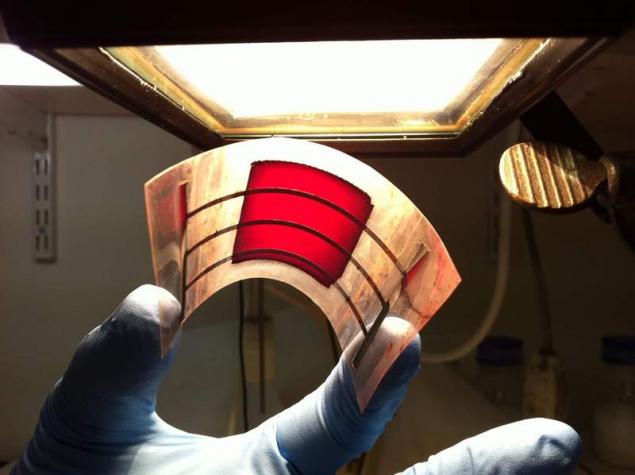
Perovskite solar cell
The advantage of perovskite units is that they are more comfortable to work with, they are easier to produce than comparable silicon cells. With mass production of perovskite solar cells price per watt of electricity could be up to $0.10. But experts believe that as long as the perovskite helium cell has reached its maximum effectiveness and begins to be produced in commercial quantities, the cost of silicon watt of electricity can be substantially reduced to achieve the same level of $0.10.
Experimentally, quantum dots and organic solar cellsThis kind of solar photovoltaics is still at an early stage of development and can not yet be considered as a serious competitor to the existing helium cells. However, developed by the University of Toronto, says that according to theoretical calculations, the efficiency of solar cells based on nanoparticles – quantum dots ‒ will be above 40%. The essence of the invention of canadian scientists is that nanoparticles – quantum dots can absorb light in different ranges of the spectrum. Changing the size of these quantum dots, we can choose the optimal range of the photoconverter.
A solar cell on the basis of quantum points
And considering that this nanoclay can be applied by spraying on any, including transparent base, the practical application of this discovery is viewed a promising prospect. And although today in the laboratories when working with quantum dots achieved the performance indicator is equal to only 11.5%, doubt the prospects of this direction is not none. And the work continues.
Solar Window – solar cell with 50% efficiency, Solar Window from Maryland (USA) presented the revolutionary technology of "solar glass", which radically changes the traditional understanding of solar cells.
There have already been reports of transparent helium technology, but also about the fact that this company promises to increase significantly the efficiency of solar modules. And, as recent events have shown, it was not just a promise but a 50% efficiency — not only theoretical refinements of the researchers of the company. While other manufacturers are just coming to the market with more modest results, Solar Window already presented its truly revolutionary high-tech developments in the field of photovoltaics helium.
These developments pave the way for the production of transparent solar panels that have significantly higher efficiency compared to traditional. But this is not the only plus new solar modules from Maryland. New helium elements can easily be attached to any transparent surfaces (e.g. Windows) can work in the shade or under artificial lighting. Thanks to the low cost investment in equipment of the building such modules can be recouped within a year. For comparison it should be noted that the payback period for traditional solar panels ranges from five to ten years, and this is a huge difference.
Solar cells Solar Window
Solar Window announced some details of the new technology for producing solar panels having such a high efficiency. Of course, the main know-how left out of the equation. Helium all items made mostly of organic material. Layers of elements consist of transparent conductors, carbon, hydrogen, nitrogen and oxygen. According to the company, the production of these solar modules is so harmless that it provides 12 times less impact on the environment than the production of traditional helium modules. Over the next 28 months of the first transparent solar panels will be installed in some buildings, schools, offices, and skyscrapers.
If to speak about prospects of development of helium photovoltaics, it seems that traditional silicon solar cells are a thing of the past, replaced by highly efficient, lightweight, multifunctional elements, which opens the widest horizons of helium energy. published
P. S. And remember, only by changing their consumption — together we change the world! ©
Source: //solarb.ru/perechen-samykh-effektivnykh-solnechnykh-batarei

Dam Solar Park, the largest SES in the world. The capacity of 850 megawatts.
The basic material for solar power plants is silicon, the supplies of which on Earth is almost inexhaustible. One problem – the efficiency of silicon solar cells is poor. The most efficient solar panels have an efficiency not exceeding 23%. And the average efficiency ranges from 16% to 18%. Therefore, researchers around the world engaged in the field of solar photovoltaics, working in order to make solar photovoltaics the image of the dear supplier of electricity.
Developed this struggle for the creation of the solar SuperCell. The main criteria – high efficiency and low cost. National laboratory of renewable energy sources (NREL) in the United States even publishes periodically a Bulletin describing interim results of this struggle. And each issue shows the winners and losers, outsiders and upstarts accidentally get involved in this race.
Leader: multilayer solar cell, These helium converters resemble a sandwich of different materials, including perovskite, silicon, and thin films. With each layer absorbs only light of a specific wavelength. As a result, these with an equal area of the working surface of the multilayer helium cells produce much more energy than others.
The record value of efficiency multilayer solar cells has been achieved at the end of 2014 a joint German-French group of researchers under the direction of Dr. Frank Dimroth at the Fraunhofer Institute for solar energy systems. Was efficiency achieved in 46%. Such a fantastic efficiency value was confirmed by an independent study at NMIJ/AIST is the largest metrological center of Japan.

The multilayer solar cell. Efficiency – 46%
These cells consist of four layers and lenses, which concentrate them to sunlight. The disadvantages include the presence in the structure of the substrate is germanium, which increases the cost of the solar module. But all the shortcomings of the layered cells are ultimately disposable, and the researchers believe that in the very near future their development will come out of the walls of laboratories in the world.
Rookie of the year — perovskiteQuite unexpectedly, the race leaders intervened beginner – perovskite. Perovskite is a General name for all material with a specific cubic structure of the crystals. Although perovskites have long been known, the study of solar cells made from these materials, began only in the period from 2006 to 2008. The initial results were disappointing: the efficiency of perovskite solar cells does not exceed 2%. The calculations showed that this figure could be much higher. Indeed, after a series of successful experiments Korean researchers in March 2016 received the confirmed efficiency of 22%, which in itself was a sensation.

Perovskite solar cell
The advantage of perovskite units is that they are more comfortable to work with, they are easier to produce than comparable silicon cells. With mass production of perovskite solar cells price per watt of electricity could be up to $0.10. But experts believe that as long as the perovskite helium cell has reached its maximum effectiveness and begins to be produced in commercial quantities, the cost of silicon watt of electricity can be substantially reduced to achieve the same level of $0.10.
Experimentally, quantum dots and organic solar cellsThis kind of solar photovoltaics is still at an early stage of development and can not yet be considered as a serious competitor to the existing helium cells. However, developed by the University of Toronto, says that according to theoretical calculations, the efficiency of solar cells based on nanoparticles – quantum dots ‒ will be above 40%. The essence of the invention of canadian scientists is that nanoparticles – quantum dots can absorb light in different ranges of the spectrum. Changing the size of these quantum dots, we can choose the optimal range of the photoconverter.
A solar cell on the basis of quantum points
And considering that this nanoclay can be applied by spraying on any, including transparent base, the practical application of this discovery is viewed a promising prospect. And although today in the laboratories when working with quantum dots achieved the performance indicator is equal to only 11.5%, doubt the prospects of this direction is not none. And the work continues.
Solar Window – solar cell with 50% efficiency, Solar Window from Maryland (USA) presented the revolutionary technology of "solar glass", which radically changes the traditional understanding of solar cells.
There have already been reports of transparent helium technology, but also about the fact that this company promises to increase significantly the efficiency of solar modules. And, as recent events have shown, it was not just a promise but a 50% efficiency — not only theoretical refinements of the researchers of the company. While other manufacturers are just coming to the market with more modest results, Solar Window already presented its truly revolutionary high-tech developments in the field of photovoltaics helium.
These developments pave the way for the production of transparent solar panels that have significantly higher efficiency compared to traditional. But this is not the only plus new solar modules from Maryland. New helium elements can easily be attached to any transparent surfaces (e.g. Windows) can work in the shade or under artificial lighting. Thanks to the low cost investment in equipment of the building such modules can be recouped within a year. For comparison it should be noted that the payback period for traditional solar panels ranges from five to ten years, and this is a huge difference.
Solar cells Solar Window
Solar Window announced some details of the new technology for producing solar panels having such a high efficiency. Of course, the main know-how left out of the equation. Helium all items made mostly of organic material. Layers of elements consist of transparent conductors, carbon, hydrogen, nitrogen and oxygen. According to the company, the production of these solar modules is so harmless that it provides 12 times less impact on the environment than the production of traditional helium modules. Over the next 28 months of the first transparent solar panels will be installed in some buildings, schools, offices, and skyscrapers.
If to speak about prospects of development of helium photovoltaics, it seems that traditional silicon solar cells are a thing of the past, replaced by highly efficient, lightweight, multifunctional elements, which opens the widest horizons of helium energy. published
P. S. And remember, only by changing their consumption — together we change the world! ©
Source: //solarb.ru/perechen-samykh-effektivnykh-solnechnykh-batarei
Open method for the production of non-flammable graphene
A 1000-strong electric car was cranked up to 350 km/h
